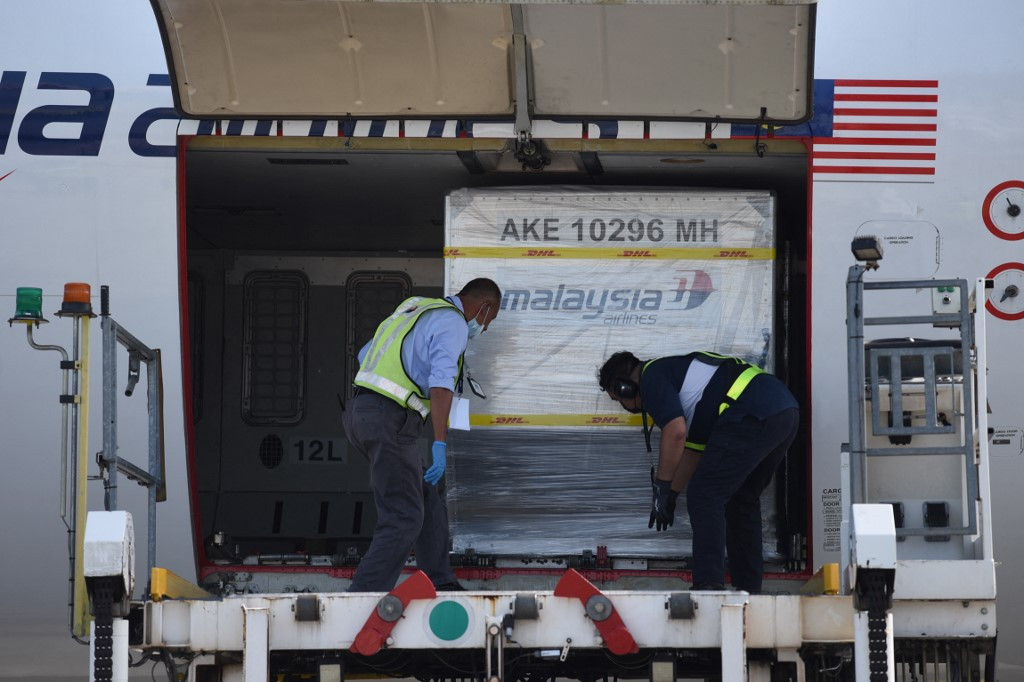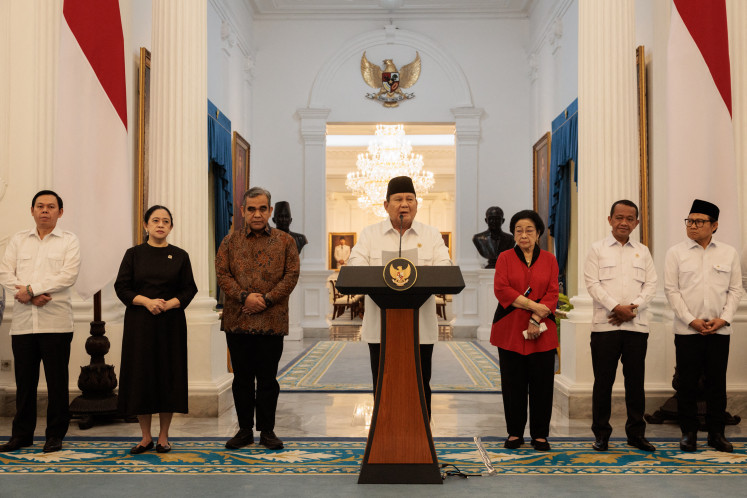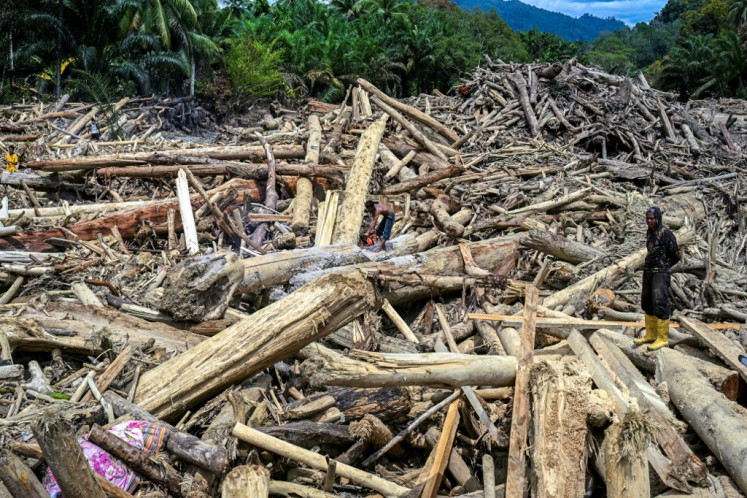Popular Reads
Top Results
Can't find what you're looking for?
View all search resultsPopular Reads
Top Results
Can't find what you're looking for?
View all search resultsMalaysia needs more than a ‘hammer’ to combat COVID-19
Herd immunity remains a distant goal for Malaysia as fewer than 10 percent of the population have received at least one dose of vaccination.
Change text size
Gift Premium Articles
to Anyone
 This handout photo from Malaysia's Department of Information taken and released on February 21, 2021 shows a cargo container (C) containing Malaysia's first shipment of Pfizer-BioNTech Covid-19 coronavirus vaccines being unloaded following its arrival at the Malaysia Airlines Berhad Cargo area near Kuala Lumpur International Airport (KLIA) in Sepang, outside Kuala Lumpur. (Agence France Presse/Handout)
This handout photo from Malaysia's Department of Information taken and released on February 21, 2021 shows a cargo container (C) containing Malaysia's first shipment of Pfizer-BioNTech Covid-19 coronavirus vaccines being unloaded following its arrival at the Malaysia Airlines Berhad Cargo area near Kuala Lumpur International Airport (KLIA) in Sepang, outside Kuala Lumpur. (Agence France Presse/Handout)
T
omas Pueyo, in a highly influential piece, commented on the need for governments to adopt both the “hammer” and “dance” to successfully combat the COVID-19 pandemic.
“Hammer” refers to strict lockdown measures implemented when COVID-19 infection numbers are rising rapidly to cut off the COVID-19 transmission chain, thereby preventing a collapse in the healthcare system. “Dance”, on the other hand, refers to a series of carefully calibrated measures which are economically and socially less disruptive.
The end goal is for the virus to be contained with the R (reproduction) value of less than one.
Pueyo’s insights appear to be spot on in the case of Malaysia’s struggle with the COVID-19 pandemic. On June 11, Malaysia announced that it would extend its second total lockdown, which started on June 1, in order to cope with the rapid surge in COVID-19 infections.
Between March 29 and May 29, daily positive cases increased by ten-fold, with director-general of health Noor Hisham warning that the country’s healthcare is “on the verge of collapse”. According to the guidelines, all economic and social activities shall cease during the duration of total lockdown except for businesses under the essential service or approved list.
Recent infection numbers have since fallen from the peak of 9,020 recorded on May 29. However, given the immense social and economic costs whenever the “hammer” strikes, it should not be seen as a viable long-term strategy. As the pandemic is unlikely to be eradicated until one’s population attains herd immunity through mass vaccination, Pueyo argued that governments meanwhile have to “dance” with the virus by carefully calibrating measures to be less economically and socially disruptive.
The government therefore needs to consider other “dance” measures. The positive rate of COVID-19 tests has risen steadily since late March and has coincided with the rapid rise in detected daily new infections cases.
The positive rate of COVID-19 tests has consistently exceeded the widely used 5 percent international benchmark since May 8, and possibly indicates that there are undetected COVID-19 infections within the community.
While Malaysia has a lower positive rate compared to Indonesia, the percentage is higher than Thailand and Singapore. Similarly, in terms of number of tests conducted per 1,000, testing numbers have not picked up dramatically despite the surge in daily infection numbers since early April.
Presently, the cost of RT-PCR (Reverse Transcription Polymerase Chain Reaction) tests in private medical institutions is a few hundred Ringgit, which may discourage some from being tested should they be ineligible for free RT-PCR tests in government clinics. The Selangor state government is offering free COVID-19 testing to all its residents in a bid to encourage mass testing, with the program attracting thousands of sign-ups each day.
The Ministry of Health (MOH) should emulate the Selangor example by setting up mass testing facilities in all other states, in collaboration with the respective state governments. To process a large number of samples within a short period of time, Antigen Rapid Test (ART) could be used instead of Polymerase Chain Reaction (PCR) test, which is presently the MOH’s preferred mode of testing.
Apart from employing a “hammer” and “dance” to manage the pandemic, it is increasingly clear that they should be complemented with a “shield” in the form of vaccines, as lockdowns and quarantines can only do so much. It is becoming apparent that vaccines are a vital aspect of the fight against the pandemic.
From this perspective, the rate of vaccinations in Malaysia has picked up pace in the past week. On June 14, Malaysia administered a record high of just under 200,000 doses. The government is hoping to eventually increase the daily vaccination rate to between 300,000 to 400,000 shots.
This renewed sense of urgency is a positive step in the right direction in Malaysia’s quest to vaccinate up to 80 percent of the country. A good example of this spirit can be seen from recent efforts by mobile outreach teams that have been sent into Sarawak’s interior to carry out COVID-19 vaccinations. This, however, can be further exemplified in the recognition for increased collaboration between the state and the private sector in enabling mass vaccinations.
The next few weeks will be a crucial test for Malaysia’s fight against COVID-19. Whether the country can effectively raise this much needed “shield” in time for its people will determine the fate of many.
***
Kevin Zhang and Kevin S.Y. Tan are respectively a research officer and a visiting senior fellow at the ISEAS – Yusof Ishak Institute. The original article was published in Fulcrum.









